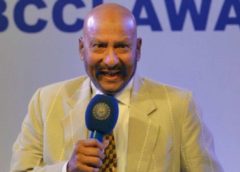
Exclusive Interview with Syed Kirmani: Wicket-keeping standard has gone down: Our correspondent, Subramanian Krishnamurthi gets up-close with the yesteryear Indian wicket-keeper, Syed Mujtaba Hussein Kirmani for ‘one-on-one’ discussion.
The 66-year old, Kiri Bhai, as he was referred to by his team-mates, and who has been the best Indian stumper, prior to the advent of MS Dhoni, travels down memory lane to relive his playing days, his world-record equalling dismissals, World Cup 1983, life after cricket et al.
Excerpts of the interview:
Kiri Bhai, how are you keeping yourself busy these days?
I am a consultant to three institutions. I am into social service. I also play golf and help coaching local cricket team as and when requested.
How did you get attracted to wicket-keeping? Generally guys always want to become bowlers or batsmen?
Living in government quarters C Type and D Type, at young age, the bigger boys in the quarters formed a cricket team. The guy older in age would be the captain. We used to play with cork ball. I was the youngest. The elderly guys would throw their weight around and I was given the responsibility of stopping the ball.
Initially I used bricks as the wicket-keeping gloves.
When I got selected for the school team, I looked at the kit bag that had the real wicket-keeping gloves which were much better than the bricks.
What are the basic qualities that go to make a good wicket-keeper?
One should be instinctive and have the passion to be a wicket-keeper. One also should have good reflexes. In our days we had no coach. The common saying is ‘wicket-keepers are born’.
When I met Alan Knott, the first time, I learnt many things from him. One has to be gifted to be a wicket-keeper.
Whom did you idolise and why?
There was no role model. I made my Ranji debut when I was in the Xth standard. Budhi Kunderan, in those days played for Karnataka and India. I used to watch him play and learnt a lot.
In 1967 I was part of the Indian School Team, the first ever team to travel abroad, went to England. At the same time the Indian Team was also touring England, under the captaincy of Mansur Ali Khan Pataudi and I had the opportunity of meeting and interacting with Farookh Engineer at Lord’s.
Do you remember the 1971 series to England when India had three wicketkeepers in the side – Engineer, Krishnamurthy and you. You entered the team, edging out Mohinder Amarnath. How did it all happen?
The year 1971 was my induction into the national team. Vijay Merchant was the Chairman of Selection Committee.
Farookh Engineer was the main wicket-keeper while P Krishnamurthy was his deputy. Engineer also had to play for his county side while playing for India in Tests.
So I was preferred by Merchant to be part of the squad in place of Mohinder Amarnath. While Engineer played the Tests, I and Krishnamurthy played the tour games.
You love to sleep a lot. In 1971 series, the Team Manager wanted you to observe how Alan Knott was going about his job. You nodded your head and once the Manager moved on, you again started sleeping. One of your team mate covered up for you. Who was that?
Ha everybody loves to sleep and relax.
Vice President, BCCI, Mathur had a habit of watching everything. When you are in the Reserves, have nothing to do, with no television, no magazines around, what else would you do? So I would quietly lie down for a small nap. Mathur would tell me to watch how Alan Knott went about doing his job behind the wicket. How long to watch Alan Knott?
Big guys always had the habit of throwing their weight around.
You made your Test debut against NZ in 1975-76 in the first Test. In your very second Test you equalled the record of six dismissals in an innings. What was your reaction then?
An Englishman used to travel on his own for all the Test matches and to all the locations and would be recording the scores. He was a thorough gentleman.
In that game, I had already taken 4 catches and effected a stumping. Richard Colinge had got out on the last ball of the day. Richard Hadlee was at the crease. At the end of the day, this gentleman came and told me that I was on the threshold of equalling a world record.
He said only three wicket-keepers, Arthur TW Grout of Australia, Denis T Lindsay of South Africa and John T Murray of England had, in the past, effected 6 dismissals in an innings in Tests, which was a world record and all those six were catches.
I had five dismissals, four of which have been catches and one stumping. I could not sleep that night. I was excited to be on the verge of equalling a world record. There was just one wicket to go. Lying on the bed I was staring at the ceiling and was wondering how to get the last one.
I had planned that I would take on any catch that came within my vicinity. I had even thought of diving upto the second slip to take the catch, if necessary. Luckily on the next day the catch of Richard Hadlee came to me straight.
I still have that ball in my collections, signed by all the six victims – Glenn Turner, Bevan Congdon, Ken Wadsworth, Dayle Hadlee, Richard Hadee and Richard Collinge.
This happened in Christchurch.
In the return series of NZ touring India in the subsequent year you ended up with the highest batting average of 65.33. Did you take your batting seriously? You ended up scoring only 2 centuries in your entire career.
See I was never considered as an all-rounder. I was always sent in to bat at No 7 or 8. So it was always with the tail – Bedi, Prasanna, Chandrasekhar and Venkatraghavan – who would be at the other end to give me company.
It was not possible to score runs with these partners who would get out and return to the pavilion faster than they came out to bat and I was always left stranded and remained ‘Not Out.’
Your first century (unbeaten 101*) came as a night watchman against Australia in 1979-80 at Wankhede in the sixth and final Test . When you were sent as night watchman after Gavaskar got out on Day 1, did you think you could hold on with Vishwanath at the other end? What did Vishy tell you?
Raj Singh Dungarpur was the chairman of the Selection Committee. I was staging a comeback after being dropped for the 1979 World Cup and the subsequent England series.
45 minutes before close of play on Day 1 when Gavaskar got out and was returning to the pavilion, Dungarpur wanted me to pad up and go in as the night-watchman. He also told me that was a ‘do or die’ match for me. I was staging a comeback and here was this warning signal. It was very much discouraging.
But I was not the one to succumb under pressure. The tough situation brought out the best in me and I came out with flying colours. My sheer grit and determination pulled me out of dire straits.
In that match you had a made a record at that time for the eighth wicket alongwith Karsan Ghavri? What did both of you discuss in the middle? What was the strategy? What was the plan? How did you guys go about building the innings?
There was no planning or strategy. We were only encouraging each other and appreciating each other for every good shot. We had discussed not to go in for any kind risky shot. We would not throw away our wicket.
We sai5d to each other that we would play according to the situation, take no risk and build the innings.
We survived and managed to put over 450 runs in the first innings and also went on to win the Test match.
Your second century (102) also came in the same ground against England in 1984-85 in the first Test of the series. Siva claimed six wickets in England’s first innings. You put on a massive 235 runs partnership for the seventh wicket alongwith Ravi Shastri. How did you guys plan the innings? What was Ravi’s strategy?
As always I went into bat at the regular No 8 position. Second new ball was due. It had always happened that whenever I went into bat, second new ball would fall due.
I always had the ‘not to give up’ attitude. I was also a flamboyant attacking batsman. My intension always was to save the Indian team. The commentators and media have always compared me with Sunil Gavaskar and Vishwanath as far as stroke making is concerned.
Both Ravi and I enjoyed each other’s company in the middle. The thought process was the same. Not to play risky shots. We were appreciating each other’s good shots and were looking to build the innings.
We put up a massive partnership and took the team score beyond 460 runs.
1983 World Cup victory was a very pleasant surprise for the entire nation. Not many gave a chance to India. How would you like to recall your innings and your partnership with Kapil Dev in the match against Zimbabwe at Turnbridge Wells? Kapil scored 175* and you were 24*. What was Kapil’s advice?
Call it ‘optimism’ and ‘believing in our capabilities’.
At the team score of 120 runs for the loss of 8 wickets with 35 overs to go – remember it was 60 overs those days – the team was in doldrums when I walked in to join Kapil in the middle.
It was a qualifying game, even though we had one more game in the league stage. A win would take us to the knockout stage. A defeat meant packing bags to go home.
Kapil was terribly disappointed and quite rightly so. It was definitely a ‘do or die’ situation for us.
I told Kapil that I would do my best to give him a stand. I would take a single and give him the rest of the over to play his shots and that was the only way to get out of the troubled situation that we were in.
It was a bouncy wicket. First two deliveries went past me. The third one which was outside the off-stump, I dispatched it to the boundary.
I was successful in giving good support to Kapil who went on plundering runs by way of 6s and 4s.
I had not seen any cricketer play the way Kapil did on that day and in such a precarious situation. It was a pleasure watching him play those shots, from the non-striker’s end.
How did you guys go about strategising and planning for the final assault in 1983 world cup? What transpired in the Team Meeting? What did Kapil tell you all?
Actually the game that we played in our tournament opener against the defending champions, the then mighty West Indies, was the turning point. We beat them convincingly and that exactly was the morale booster for us.
We started to believe in our strength and capabilities. We believed that we could beat a team as strong as the West Indies, who were the world champions at that point of time.
This feeling started playing in the mind of all the players. Our team had seven all-rounders and that was a very vital point.
Kapil said, “I don’t have to tell or advice. You are seven seniors and you should guide.”
Each one of us knew our responsibility. Our course ‘Lady Luck’ also favoured us on that day.
We never had any coach or support staff. We just had a Team Manager. In the team meetings we always discussed about the pluses and minuses of the opposition.
We always believed in putting our best foot forward and it worked.
How would you like to recall the catch you took to dismiss Faoud Bachchus in the 1983 world cup final?
Oh that was one of the best catches, I had ever taken. In fact every falling wicket gave us a lot of energy and enthusiasm and egged us to do better and better until we reached the target.
At what point of time did you all realise that you could win the title?
Everybody had their own thoughts. The dismissal of the top 5 wickets was the silver lining. It gave all of us a feeling that we could possibly make it. But it was too early to celebrate. You never know. Even the last pair might make your life difficult.
So we all waited until Mohinder Amarnath sent back Michael Holding, wrapping him on the pads, leg before wicket.
What was the celebration like at the Lord’s?
Oh the celebration was unbelievable, unimaginable. Each one of us went out with our friends and celebrated in our own way.
A leg injury more or less drew curtains on your career and you had to make way for the likes of Kiran More, Chandrakant Pandit etc. How did it all happen?
Actually a lot of things happened then and I don’t want to recall those days. I will not disclose now. I lost my place in the team when my performance graph was going up.
You will get to read all those in my autobiography.
You tried your hands at the tinsel town. You played the role of BAD MAN in Kabhi Ajnabi The. Your team mate Sandip Patil also featured in that. What happened later? Why did you not pursue film acting?
Actually that is a wrong depiction. I was not the villain in the movie. It was Shakti Kapoor. My role was to protect the good guys and eradicate the bad ones.
You also acted in a Malayalam movie. What happened later on?
Yes it was a very nice story of a Pakistani based in England, who came to India to play cricket and I was his coach. I also acted in a couple of Kannada films which was also related to cricket.
My passion is cricket and would always like to remain attached to the game in some way or the other.
Coming to modern day cricket, after Dhoni, who you think can and should shoulder the wicket-keeping responsibilities?
Wicket-keeping standard has actually gone down after the advent of limited over cricket. Bowling, batting and fielding have designated coaches but there is no coach for wicket-keeping, which is a specialised position in the team. Wicket-keeping has taken back seat.
Wicket-keeping is done by part-timers like we have part-time bowlers. These days wicket-keeper is actually a batsman who could stop the ball.
Well, Wridhhiman Saha has taken over the responsibility now. We also have the likes of Dinesh Karthik, Parthiv Patel.
Do you regret not having IPL kind of thing during your playing days? How does IPL help a player in his career, other than the financials?
No regrets. Variety is spice of art. From Test we had 60-overs then moved on to 50-overs and then to 20-over games. This is what the paying public wants and they are getting.
Why are you not involving in the games administration?
I have very honestly made many approaches to BCCI stating that I wanted to give back to the game that has given me so much of name and fame. But somehow, according to them, I don’t qualify. I really don’t understand.
Whom do you consider as your best room-mate during your playing days and is there any interesting episode which you would like to share?
Well you see, I have gelled with everyone. All have been good friends. I can only speak from my side. I have been able to adjust and accommodate everyone. I had no issue. I enjoyed everybody’s company.
Before we sign off, would you like to add anything else, Kiri Bhai?
In the current scenario no technique is reqd. One of my shows in a private television channel also had Dhoni’s coach as the guest. The anchor asked me about Dhoni and I told him to take the views of Dhoni’s coach.
The coach said that Dhoni did not have any technique in either wicket-keeping or batting. Next the anchor asked for my comments.
I said Dhoni is the most successful Indian Captain, thus far. He had won the World Cup title in both the formats. He has successfully taken the team to the No 1 slot in all the three formats. He also has been the most consistent batsman. He possesses the quality of a good captain. What more would a team be looking for? Technique or the end-result? Obviously the ‘end-result’ is all that matters.













